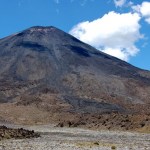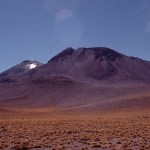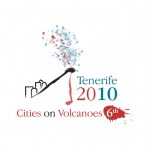News for Monday!
Ngauruhoe in New Zealand, showing the dark lava flows of basaltic andesite on the slopes of the young volcanic cone. Image by Erik Klemetti, taken January 2009.
A couple pieces of news from two Russian volcanoes on the Kamchatka Peninsula: (1) last week's report of activity at Gorely appears to be semi-substantiated with new photos on the KVERT website (Russian). The images from June 6 and 12 (2010) shows steam plumes coming from the volcano - one as tall as 500 meters. Now, this doesn't imply that an eruption occurred, but it might suggest activity on on the upswing. KVERT…

This week went fast, didn't it?
The Baekdu caldera along the North Korean/Chinese border.
The NASA Earth Observatory have been giving us a steady diet of volcanic plumes over the last week, including PNG's Ulawun, Russia's Sarychev Peak (a very faint plume), both an ASTER and Terra image of the summit region at Kliuchevskoi and finally a mix of plume and clouds over PNG's Manam volcano.
I wanted to also mention a brief article I ran into on the Changbaishan/Baekdu caldera along the Chinese and North Korean border. Although short on specifics, this article mentions a number of interesting (…
Have guests in town, so I'm a little busy, but you can hopefully keep entertained with the latest Smithsonian/USGS Global Volcanism Program Volcanic Activity Report.
Chile's Melimoyu volcano.
The highlights (not including Taal and Eyjafjallajökull) include:
Alaska's Cleveland volcano has been reduced to and alert status of "unassigned" (used when a volcano is not closely monitored so AVO doesn't know what exactly is "background") after a few weeks of activity. The same was done for the submarine volcano south of Sarigan in the Marianas Islands after no signs of activity since the eruption…
The crater lake at Eyjafjallajökull as seen on June 11, 2010. Image from the Icelandic Met Office by Sveinn Brynjólfsson.
After keeping us transfixed for almost two months this spring, Eyjafjallajökull has slowly drifted from the headlines. However, this doesn't mean that interesting things - volcanologically-speaking - have stopped happening at the Icelandic volcano. For one, a crater lake has now been spotted at the summit vent of the volcano. This lake is steaming vigorous, but at the end of last week, the Icelandic Meteorological Office and the Institute of Earth Sciences declared…
The crater lakes at the summit of Gorely volcano in Russia.
Possibly lost in the vuvuzela noise, but Eruptions readers over the weekend noted that Gorely on the Kamchatka Peninsula in Russia had its first eruption in over 20 years. The Russian media has a brief report mentioning that the volcano produced an ash plume that "stretched over a hundred kilometers" (horizontally). The plume was causing some disruptions of local air travel and threatening a geothermal plant, but no real other details beyond that were offered. So far, there has been no update about the possible eruption on the KVERT…
Volcano Island in the caldera lake at Taal.
The Philippine government is upping its concern about an eruption at Taal - and cracking down on tourists and resorts trying to get near Volcano Island in the volcano's caldera lake. Tourists are only allowed to take boat tours in the lake that go halfway to the island - which doubles as the most recently active vent at Taal - and if resorts on the lake bring tourists any closer, they may face repercussions from the government. Of course, this still isn't stopping tourists and natives from going to the island anyway. Now, one thing interesting to…
On advice of Eruptions reader Ekoh, I thought it would be fun to try to come up with a list of the most tongue-twisting and bizarre volcano names out there. I know there are a few out there that I've only typed once (the rest of the time I cut-and-paste), so lets review some recent fun ones:
Eyjafjallajökull (Iceland) - everyone's favorite tongue twister.
Eyjafjallajökull erupting in mid-May, 2010.
And people are still talking about the how the ash crisis was handled.
Kliuchevskoi (Russia) - It doesn't help that it has like ten names to boot (from the Smithsonian GVP):
KAMCHATSKAIA GORA…
A partially-eroded scoria cone in the Taal volcano caldera.
As I mentioned earlier this week, PHIVOLCS has raised the Alert Status at Taal in the Philippines to 2 (out of 5) after increasing tremors and gas emissions from the volcano's crater lakes. Now, the Philippine government is taking this threat very serious, sending divers, helicopters, rescue equipment and medical teams to the area near the volcano in case an eruption occurs. Provincial officials in Batangas have asked 5,000 people living near Taal to voluntarily evacuate - however, as with many evacuations, people are reluctantly to…
The latest update from the Smithsonian/USGS Global Volcanism Program!
Highlights (not including Taal, Eyjafjallajökull and Bezymianny) include:
Another thermal anomaly was spotted on an Kuril Island volcano - this one being Tiatia. The volcano has no seismic monitoring network, so the thermal anomaly is all that has been observed.
Lava flows and strombolian explosions continue at Guatemala's Pacaya. Some of the explosions have launched bombs hundreds of meters into the air.
Kliuchevskoi was another busy Russian volcano, with a large thermal anomaly and ash explosions that produced a plume…
The steaming vent area at Taal in the Philippines in September 1965, when the volcano produced a VEI 4 eruption.
The Philippine Institute of Volcanology and Seismology (PHIVOLCS) has raised the alert status at Taal to Level 2 (of 4) and officials in the Philippines are getting ready if the volcano does come back to life for the first time since 1977. Taal is a mere 48 km (30 miles) from Manila - the capital of the Philippines and home to over 21,000,000 people in the metro area of the city. This location made Taal one of the UN/IAVCEI Decade Volcanoes as a large eruption from the volcano…
Last year I mentioned the fundraiser for the excellent Mt. Baker Volcano Research Center - and lo and behold, I will mention it again. The new 2010 t-shirts are out and you can purchase one to support one of the best volcano research sites on the web (and off the web) - with a plethora of information on Mt. Baker, updates on the research going on at the volcano and any news of activity from Washington's northern-most volcano.
2010 MBVRC t-shirt. Click to enlarge image.
This year's t-shirt features Mt. Baker's eruptive history (see above) and can be yours by visiting the MBVRC blog site. You…
Looking for some volcano news - you've found it.
A shot of volcano "tourists" near the erupting Pacaya. Photo by the Associated Press.
Eruptions reader Dr. Boris Behncke dropped a note that Kilauea has not one but two active lava lakes right now. The lava lakes can be seen on the webcams for the Halema`uma`u Crater and the Pu`u O`o flank vent. The latest status update from June 6th by the USGS Hawaiian Volcano Observatory talks about both the summit and rift activity (video) on Kilauea as well. Meanwhile, Hawaii 24/7 has a piece in the Volcano Watch series about whether residents of Maui…
Image of the Eyjafjallajökull's ash taken on May 26, 2010, courtesy of the NASA Earth Observatory.
Eruptions readers were closely following increasing tremors at Eyjafjallajökull this afternoon/evening wondering if there was a new eruption starting but with the weather not cooperating, no one was sure. However, this evening the Icelandic Met Office released a statement (Icelandic) saying that a small explosion of gas and ash did occur today. The update is only available (so far) on the Icelandic version of the IMO website - so I had to work through a Google Translate version of the story…
The NASA Earth Observatory has been dazzling us with images from the Eyjafjallajökull eruption for months - but they have been dazzling us with volcanoes images for years! Here are two more images for those of you who love seeing volcanoes from above:
Cleveland, Alaska
As I mentioned earlier this week, Cleveland volcano likely had a small eruption over the weekend producing a small ash cloud. Cleveland is already known as an extremely picturesque volcano, both from the ground for its highly conical shape - a textbook andesitic stratocone - and from space. This new June 1 image is from almost…
The level of news-frenzy on some of the recent volcanic eruptions has died down, but if you're looking to see information on the many rumbling going on worldwide, look no further. Here is this week's Volcanic Activity Report put together by Sally Kuhn Sennert of the Global Volcanism Program.
Highlights - not including Pacaya, Yasur, Tungurahua and our friend in Iceland - include:
The eruption in the Marianas apparently came from South Sarigan volcano - at least according to the best guess by folks who work in the Marianas. This submarine volcano apparently shows evidence of young lava flows…
Tungurahua in Ecuador erupting on May 31, 2010.
Two volcanoes along the edge of the north Pacific had explosive eruptions over the weekend. We have some more details on both of the eruptions, so I'll pass them on:
Bezymianny
KVERT is excited because they claim to have predicted the explosive eruption of Bezymianny almost to the day. They had been closely monitoring the volcano and issued this statement on May 20:
According to satellite data by AVO and KVERT staff, a temperature of
the thermal anomaly over the lava dome of Bezymianny volcano began
increasing from May 19 (from -1 (9:49 UTC) to…
Undated image of Bezymianny in Kamchatka.
Eruptions reader M. Randolph Kruger just let us in on a significant eruption at Bezymianny in Kamchatka. The AVO/KVERT alert for the volcano suggests a fairly significant explosive eruption that might cause some snarls in the international air travel over the Kamchatka Peninsula. The KVERT statement:
A strong explosive eruption of Bezymianny volcano occurred from 12:34 till 12:50 UTC on May 31, according to seismic data. Ash fall in Kozyrevsk village is continuing. The volcano obscured by clouds. A big ash cloud remains over Kamchatka at present (…
This week is the Cities on Volcanoes conference - now in its sixth iteration. This year the conference is in Tenerife in the Canary Islands and while I wish I could be there, I'm not. However, we can all live vicariously through Dr. David Calvo, who will be sending daily updates from the meeting. He's been busy with the usual first day activities of someone helping run a meeting, but here is his first blurb from Tenerife:
CitiesonVolcanoes6 started just today at Puerto de la Cruz (Tenerife, Spain), and right now more than 700 people are sharing their knowledge about volcanism and volcanic…
Quick news on Memorial Day (in the US at least):
Ash soaked by rain from Tropical Storm Agatha on the roofs of homes in Guatemala after the late May eruption of Pacaya.
Sixteen scientists were evacuated from islands in the northern Marianas due to the eruption of the unnamed submarine volcano south of Sarigan Island. The eruption is continuing to be monitored closely by the USGS and National Weather Service as the plume - which is most steam with minor ash - could disrupt air traffic in/around Saipan. The latest USGS CNMI update:
Seismicity at a single nearby station on Sarigan Island…
Sarigan Island in the northern Mariana Islands. An undersea eruption appears to be underway south of the island.
Thanks to the watchful eye of Eruptions readers, we had an inkling of this eruption the other day, but now we have confirmation that an undersea eruption is underway in the northern Mariana Islands. The exact volcano erupting is unknown, but it appears to be between Anatahan and Sarigan (see below) - both active volcanoes in the Marianas - at a depth of 300 meters. The eruption has been described by the USGS as hot water vapor and an ash plume that might have reached as high as 12…



